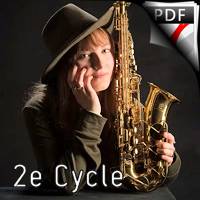Download your PDF score!
By music teachers, for their students
| Title | Author | Set | Prices | ||
|---|---|---|---|---|---|

|
Aragonaise |
Georges Bizet |
Quatuor de saxophones |
7.90€ |
|

|
Amazing Grace (Saxophone Quartet) |
Traditionnel Américain |
Quatuor de Saxophones |
7.90€ |
|

|
Berliner Luft |
Paul Lincke |
Quatuor de Saxophones |
7.90€ |
|

|
La Cumparsita (Saxophone Quartet) |
Gerardo Matos Rodriguez |
Quatuor de Saxophones |
7.90€ |
|

|
Confixit (Saxophone Quartet) |
Adrien Veys |
Quatuor de Saxophones |
7.90€ |
|

|
Miserere |
Gregorio Allegri |
Quatuor de Saxophones |
7.90€ |
|

|
Für Elise (Saxophone Quartet) |
Ludwig Van Beethoven |
Quatuor de Saxophones |
5.90€ |
|

|
Volver (Saxophone Quartet) |
Carlos Gardel |
Quatuor de Saxophones |
14.90€ |
|

|
Pavane de Fauré |
Gabriel Fauré |
Quatuor de Saxophones |
7.90€ |
|

|
Canon Pachelbel |
Johann Pachelbel |
Quatuor de Saxophones |
7.90€ |
A saxophone quartet is an ensemble made up of four saxophones, typically soprano, alto, tenor and baritone. Different members of the saxophone family are used to provide a wider range and variety of tonal colours.
The saxophone was developed in 1840 by Adolphe Sax, a Belgian flutist and clarinettist based in Brussels. Sax made considerable efforts to popularise the instrument, but was opposed by his fellow instrument makers of the time. Although originally conceived as an orchestral instrument, it was through military music that the instrument first experienced significant growth. The composer Jean-Baptiste Singelee wrote scores for four saxophones in the 19th century. These include the Allegro de concert (AATB), the Quatuor en 4 Parties (SATB) and the Grand Quatuor Concertant en 3 Parties (SATB). In 1878, the Gilmour Band featured a saxophone quartet with Edouard Lefèbre as soloist. In 1905, Lefèbre formed his own saxophone quartet with a repertoire of transcriptions.
Marcel Mule was the second saxophone teacher at the Paris Conservatoire after Adolphe Sax himself. In 1928, he founded the Quatuor de la Musique de la Garde Républicaine, later known as the Quatuor de saxophones de Paris, and later the Quatuor Marcel Mule. The founding members were:
Many of the works for saxophone quartet that now form part of the standard repertoire were written for this ensemble. Mule himself also arranged works for the ensemble.
Daniel Deffayet was a pupil of Marcel Mule and later taught saxophone at the Paris Conservatoire. In 1953, he founded the "Quatuor de Saxophones Daniel Deffayet".
Jean-Yves Fourmeau formed his own quartet in 1979. These ensembles have made a significant contribution to expanding the repertoire through their work with composers. Among the renowned composers who have written scores for the quartets are Phil Woods, Alexander Glazunov, Eugene Bozza, Philip Glass and others. Since the 1970s, jazz quartets have begun to emerge, broadening the scope of the ensemble and the idiom of the repertoire.
Saxophone quartets abound in amateur, professional and university ensembles. The last World Saxophone Congress, in 2015, organised a competition specifically for saxophone quartets with a first prize of €4,000 and a recital, won by the Keuris Saxophone Quartet.
While the SATB remains the most common classical configuration, the soprano is sometimes replaced by another alto, leading to an AATB configuration, particularly in jazz and contemporary ensembles. Other configurations exist, notably the Four Baritones Quartet.
Our PDF scores for Saxophone Quartet are published with the 4-part conductor as well as the separate parts. One of our best-sellers for 3e cycle is Richard Galliano's "Tango pour Claude", a tribute to Claude Nougaro.
